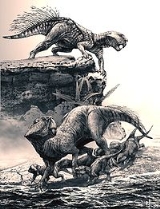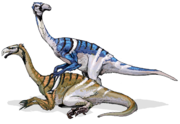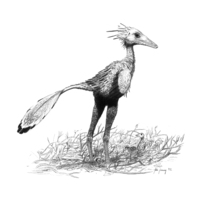
Xinminbao Group
Encyclopedia
The Xinminbao Group is a group of geological formations in north central China
. They occur across a large depression
between the Altai mountains of Mongolia
to the north and the Qilian mountains of the Qinghai Plateau to the south, in the Gonpoquan and Suanjingze basin
s, and also in the neighbouring Jiuquan
Basin.
Both of these areas are inland basins consisting of fluvial
(river), lacustrine
(lake), and intermontane
(between mountains) alluvial fan
(floodplain) sediment
s that were deposited during the Early Cretaceous
, probably during the Aptian
or possibly late Barremian
stage
, when the climate was semi-arid
and subtropical.
The Group has been visited by many expeditions including the Silk Road
dinosaur expedition of
1992 which concentrated on the area around Mazong Shan
.
s grading to fine sandstone
s representing river channel to alluvial fan deposits, and an upper unit of red clastic sediments from either overbank deposits in a meandering fluvial environment, or accumulation in a shallow lacustrine or paludal
(marsh) environment.
s and calcareous
mudstone
s comprising two sequences
of fluvio-lacustrine sedimentation with some alluvial fan and littoral
(lake-shore) deposits.
cycles of lacustrine sediments.
China
Chinese civilization may refer to:* China for more general discussion of the country.* Chinese culture* Greater China, the transnational community of ethnic Chinese.* History of China* Sinosphere, the area historically affected by Chinese culture...
. They occur across a large depression
Depression (geology)
A depression in geology is a landform sunken or depressed below the surrounding area. Depressions may be formed by various mechanisms.Structural or tectonic related:...
between the Altai mountains of Mongolia
Mongolia
Mongolia is a landlocked country in East and Central Asia. It is bordered by Russia to the north and China to the south, east and west. Although Mongolia does not share a border with Kazakhstan, its western-most point is only from Kazakhstan's eastern tip. Ulan Bator, the capital and largest...
to the north and the Qilian mountains of the Qinghai Plateau to the south, in the Gonpoquan and Suanjingze basin
Basin (geology)
A structural basin is a large-scale structural formation of rock strata formed by tectonic warping of previously flat lying strata. Structural basins are geological depressions, and are the inverse of domes. Some elongated structural basins are also known as synclines...
s, and also in the neighbouring Jiuquan
Jiuquan
- Suzhou town :The administrative center of the "prefecture-level city" of Jiuquan is the "District" of Suzhou , which occupies 3,386 square km in the eastern part of Jiuquan "prefecture-level city", and had a population of 340,000 as of 2002....
Basin.
Both of these areas are inland basins consisting of fluvial
Fluvial
Fluvial is used in geography and Earth science to refer to the processes associated with rivers and streams and the deposits and landforms created by them...
(river), lacustrine
Lake
A lake is a body of relatively still fresh or salt water of considerable size, localized in a basin, that is surrounded by land. Lakes are inland and not part of the ocean and therefore are distinct from lagoons, and are larger and deeper than ponds. Lakes can be contrasted with rivers or streams,...
(lake), and intermontane
Intermontane
Intermontane is a physiographic adjective formed from the prefix "inter-" and the adjective "montane" Usage includes intermontane basin such as New Zealand's Mackenzie Basin and intermontane...
(between mountains) alluvial fan
Alluvial fan
An alluvial fan is a fan-shaped deposit formed where a fast flowing stream flattens, slows, and spreads typically at the exit of a canyon onto a flatter plain. A convergence of neighboring alluvial fans into a single apron of deposits against a slope is called a bajada, or compound alluvial...
(floodplain) sediment
Sediment
Sediment is naturally occurring material that is broken down by processes of weathering and erosion, and is subsequently transported by the action of fluids such as wind, water, or ice, and/or by the force of gravity acting on the particle itself....
s that were deposited during the Early Cretaceous
Early Cretaceous
The Early Cretaceous or the Lower Cretaceous , is the earlier or lower of the two major divisions of the Cretaceous...
, probably during the Aptian
Aptian
The Aptian is an age in the geologic timescale or a stage in the stratigraphic column. It is a subdivision of the Early or Lower Cretaceous epoch or series and encompasses the time from 125.0 ± 1.0 Ma to 112.0 ± 1.0 Ma , approximately...
or possibly late Barremian
Barremian
The Barremian is an age in the geologic timescale between 130.0 ± 1.5 Ma and 125.0 ± 1.0 Ma). It is a subdivision of the Early Cretaceous epoch...
stage
Faunal stage
In chronostratigraphy, a stage is a succession of rock strata laid down in a single age on the geologic timescale, which usually represents millions of years of deposition. A given stage of rock and the corresponding age of time will by convention have the same name, and the same boundaries.Rock...
, when the climate was semi-arid
Semi-arid
A semi-arid climate or steppe climate describes climatic regions that receive precipitation below potential evapotranspiration, but not extremely...
and subtropical.
The Group has been visited by many expeditions including the Silk Road
Silk Road
The Silk Road or Silk Route refers to a historical network of interlinking trade routes across the Afro-Eurasian landmass that connected East, South, and Western Asia with the Mediterranean and European world, as well as parts of North and East Africa...
dinosaur expedition of
1992 which concentrated on the area around Mazong Shan
Mazong Shan
The Mazong Shan is a minor mountain range of northern Gansu, between the Altay range to the north and the Qilian range to the south. The Mazong Shan peak rises to 2584 m....
.
Chijinbao Formation
This consists of a lower Red Unit of coarse conglomerateConglomerate (geology)
A conglomerate is a rock consisting of individual clasts within a finer-grained matrix that have become cemented together. Conglomerates are sedimentary rocks consisting of rounded fragments and are thus differentiated from breccias, which consist of angular clasts...
s grading to fine sandstone
Sandstone
Sandstone is a sedimentary rock composed mainly of sand-sized minerals or rock grains.Most sandstone is composed of quartz and/or feldspar because these are the most common minerals in the Earth's crust. Like sand, sandstone may be any colour, but the most common colours are tan, brown, yellow,...
s representing river channel to alluvial fan deposits, and an upper unit of red clastic sediments from either overbank deposits in a meandering fluvial environment, or accumulation in a shallow lacustrine or paludal
Paludal
Paludal is derived from the Latin word palus .*Paludal, in geology, refers to sediments that accumulated in a marsh environment.*Paludal, in ecology, refers to the environment of a marsh.----...
(marsh) environment.
Digou Formation
This consists of grey siltstoneSiltstone
Siltstone is a sedimentary rock which has a grain size in the silt range, finer than sandstone and coarser than claystones.- Description :As its name implies, it is primarily composed of silt sized particles, defined as grains 1/16 - 1/256 mm or 4 to 8 on the Krumbein phi scale...
s and calcareous
Calcareous
Calcareous is an adjective meaning mostly or partly composed of calcium carbonate, in other words, containing lime or being chalky. The term is used in a wide variety of scientific disciplines.-In zoology:...
mudstone
Mudstone
Mudstone is a fine grained sedimentary rock whose original constituents were clays or muds. Grain size is up to 0.0625 mm with individual grains too small to be distinguished without a microscope. With increased pressure over time the platey clay minerals may become aligned, with the...
s comprising two sequences
of fluvio-lacustrine sedimentation with some alluvial fan and littoral
Littoral
The littoral zone is that part of a sea, lake or river that is close to the shore. In coastal environments the littoral zone extends from the high water mark, which is rarely inundated, to shoreline areas that are permanently submerged. It always includes this intertidal zone and is often used to...
(lake-shore) deposits.
Zhonggou Formation
This consists of red siltstones and mudstones in a series of upwardly coarseningcycles of lacustrine sediments.
Ceratopsians
| Ceratopsians reported from the Xinminbao Group | ||||||
|---|---|---|---|---|---|---|
| Genus | Species | Location | Stratigraphic position | Material | Notes | Images |
Archaeoceratops Archaeoceratops Archaeoceratops, meaning "ancient horned face", is a genus of basal neoceratopsian dinosaur from the Early Cretaceous of north central China. It appears to have been bipedal and quite small with a comparatively large head... |
Archaeoceratops oshimai |
"[Two] individuals lacking forelimbs." |
.jpg) |
|||
Auroraceratops Auroraceratops Auroraceratops, meaning "dawn horned face", is a genus of basal neoceratopsian dinosaur, from the Early Cretaceous of north central China... |
Auroraceratops rugosus |
|||||
Microceratus |
Microceratus gobiensis |
|||||
Microceratus sulcidens |
||||||
Psittacosaurus Psittacosaurus Psittacosaurus is a genus of psittacosaurid ceratopsian dinosaur from the Early Cretaceous Period of what is now Asia, about 130 to 100 million years ago. It is notable for being the most species-rich dinosaur genus... |
Psittacosaurus mazongshanensis |
"One individual lacking caudal and hindlimb." |
||||
Crocodilians
Indeterminate crocodilian remains are known from the group.| Crocodilians reported from the Xinminbao Group | ||||||
|---|---|---|---|---|---|---|
| Genus | Species | Location | Stratigraphic position | Material | Notes | Images |
Chiayusuchus Chiayusuchus Chiayusuchus is an extinct genus of stomatosuchid crocodylomorph. Fossils have been found from the Xinminbao Group in Gansu, China. It existed during the Barremian and Aptian stages of the Early Cretaceous. It was in the same family as the large, flat-snouted crocodilian Stomatosuchus.-External... |
Chiayusuchus cingulatus |
|||||
Fish
| Ray-finned fishes reported from the Xinminbao Group | ||||||
|---|---|---|---|---|---|---|
| Genus | Species | Location | Stratigraphic position | Material | Notes | Images |
Xixiaichthys |
Xixiaichthys tongxinensis |
|||||
Ornithopods
| Ornithopod Ornithopod Ornithopods or members of the clade Ornithopoda are a group of ornithischian dinosaurs that started out as small, bipedal running grazers, and grew in size and numbers until they became one of the most successful groups of herbivores in the Cretaceous world, and dominated the North American... s reported from the Xinminbao Group |
||||||
|---|---|---|---|---|---|---|
| Genus | Species | Location | Stratigraphic position | Material | Notes | Images |
Equijubus Equijubus Equijubus, meaning "horse mane" after the area in which it was found, is a genus of herbivorous hadrosauroid dinosaur from the Early Cretaceous of northwestern China.-Discovery and naming:... |
Equijubus normani |
"Skull and partial postcranial skeleton." |
(both this and Probactrosaurus are properly hadrosauroids Hadrosauroidea Hadrosauroidea is a clade or superfamily of ornithischian dinosaurs that includes the "duck-billed" dinosaurs, or hadrosaurids, and their close relatives. Many primitive hadrosauroids, such as the sail-backed Ouranosaurus, have traditionally been included in a paraphyletic "Iguanodontidae"... rather than hadrosaurid Hadrosaurid Hadrosaurids or duck-billed dinosaurs are members of the family Hadrosauridae, and include ornithopods such as Edmontosaurus and Parasaurolophus. They were common herbivores in the Upper Cretaceous Period of what are now Asia, Europe and North America. They are descendants of the Upper... s) |
 |
||
Probactrosaurus Probactrosaurus Probactrosaurus is an early herbivorous hadrosauroid iguanodont dinosaur. It lived in China during the Early Cretaceous period.... |
Probactrosaurus mazongshanensis |
"Partial skull and postcranial skeleton." |
||||
Siluosaurus Siluosaurus Siluosaurus is a genus of ornithopod dinosaur from the Barremian-Albian-age Lower Cretaceous Xinminbao Group of Gansu, China. It is based on IVPP V.11117 , two teeth... |
Siluosaurus zhangqiani |
"Teeth." |
Nomen dubium Nomen dubium In zoological nomenclature, a nomen dubium is a scientific name that is of unknown or doubtful application... , tentatively classified as a Hypsilophodontid. |
|||
Pterosaurs
| Pterosaur Pterosaur Pterosaurs were flying reptiles of the clade or order Pterosauria. They existed from the late Triassic to the end of the Cretaceous Period . Pterosaurs are the earliest vertebrates known to have evolved powered flight... s reported from the Xinminbao Group |
||||||
|---|---|---|---|---|---|---|
| Genus | Species | Location | Stratigraphic position | Material | Notes | |
Noripterus Noripterus Noripterus is a genus of dsungaripterid pterodactyloid pterosaur from Lower Cretaceous-age Lianmuqin Formation in the Junggar Basin of Xinjiang, China. It was first named by Yang Zhongjian in 1973... |
Indeterminate |
|||||
Saurischians
Indeterminate allosaurid, dromaeosaurid, and ornithomimmid, remains are known from the Xinminbao Group. Indeterminate nemegtosaurid remains are also known from the group.| Saurischians reported from the Xinminbao Group | ||||||
|---|---|---|---|---|---|---|
| Genus | Species | Location | Stratigraphic position | Material | Notes | Images |
Asiatosaurus Asiatosaurus Asiatosaurus was a genus of herbivorous sauropod dinosaur which lived during the early Cretaceous. Its fossils have been found in China and Mongolia. It is known only from teeth, making it difficult to rely on information until more specimens are found to expand our knowledge.The type species, A.... |
Asiatosaurus mongoliensis |
  |
||||
Chiayusaurus Chiayusaurus Chiayusaurus was a genus of sauropod dinosaur known from teeth found in Asia. Two species have been named for this obscure genus. It was originally named as Chiayüsaurus, but the ICZN does not permit special characters, so it has become Chiayusaurus... |
||||||
Gobititan Gobititan Gobititan is a genus of dinosaur from the mid-Cretaceous. The genus is based on one partial skeleton, composed of spinal vertebrae and a partial limb. Based on the partial skeleton, it is believed to have been a basal titanosaur, a type of sauropod. The type species, Gobititan shenzhouensis, was... |
Gobititan shenzhouensis |
|||||
Nanshiungosaurus Nanshiungosaurus Nanshiungosaurus is a genus of therizinosaurian theropod dinosaur from the Cretaceous of China.Two species have been named in the genus: the type species Nanshiungosaurus brevispinus and Nanshiungosaurus bohlini.-Discovery and naming:... |
Nanshiungosaurus bohlini |
"[Sixteen] cervical and dorsal vertebrae." |
This species may not belong in Nanshiungosaurus. |
|||
Sinornithoides Sinornithoides Sinornithoides is a genus of troodontid theropod dinosaur. It lived during the Early Cretaceous . It measured approximately 1 meter long... |
Indeterminate |
|||||
Thyreophorans
Indeterminate ankylosaur remains are known from the group.| Thyreophorans of the Xinminbao Group | ||||||
|---|---|---|---|---|---|---|
| Genus | Species | Location | Stratigraphic position | Abundance | Notes | |
Heishansaurus Heishansaurus Heishansaurus, meaning "Heishan lizard" after the area in China where it was discovered, is the name given to a dubious genus of dinosaur. First described in 1953 as a pachycephalosaur, this dinosaur may actually be an ankylosaur. The fossils, dating from the Late Cretaceous , are fragmentary, and... |
Heishansaurus pachycephalus |
(nomen dubium - originally described as, and may be, a pachycephalosaur) |
||||
Stegosaurides Stegosaurides Stegosaurides is a genus of ankylosaurid dinosaur. It lived during the Late Cretaceous. Its fossils were found in the Xinminbao Formation near Heishan in Gansu Province in China. These fossils consist of fragmentary material, including spinal elements... |
Stegosaurides excavatus |
(nomen dubium) |
||||
Turtles
| Turtle Turtle Turtles are reptiles of the order Testudines , characterised by a special bony or cartilaginous shell developed from their ribs that acts as a shield... s of the Xinminbao Group |
||||||
|---|---|---|---|---|---|---|
| Genus | Species | Location | Stratigraphic position | Abundance | Notes | |
Tsaotanemys |
Tsaotanemys rugosus |
|||||

